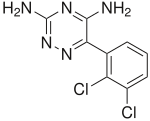Lamictal
 |
|
 |
|
| Clinical data | |
|---|---|
| Pronunciation | /ləˈmoʊtrᵻˌdʒiːn/ |
| Trade names | Originally Lamictal, many brands worldwide |
| AHFS/Drugs.com | Monograph |
| MedlinePlus | a695007 |
| License data |
|
| Pregnancy category |
|
| Routes of administration |
Oral |
| ATC code | |
| Legal status | |
| Legal status | |
| Pharmacokinetic data | |
| Bioavailability | 98% |
| Protein binding | 55% |
| Metabolism | Hepatic (mostly UGT1A4-mediated) |
| Biological half-life | 29 hours |
| Excretion | Urine (65%), faeces (2%) |
| Identifiers | |
|
|
| CAS Number | |
| PubChem CID | |
| IUPHAR/BPS | |
| DrugBank | |
| ChemSpider | |
| UNII | |
| KEGG | |
| ChEBI | |
| ChEMBL | |
| ECHA InfoCard | 100.074.432 |
| Chemical and physical data | |
| Formula | C9H7Cl2N5 |
| Molar mass | 256.091 g/mol |
| 3D model (Jmol) | |
|
|
|
|
|
|
|
Lamotrigine, originally marketed as Lamictal and available under many brands worldwide, is an anticonvulsant drug used in the treatment of epilepsy and bipolar disorder. It is also used off-label as an adjunct in treating clinical depression. For epilepsy, it is used to treat focal seizures, primary and secondary tonic-clonic seizures, and seizures associated with Lennox-Gastaut syndrome. Like many other anticonvulsant medications, lamotrigine also seems to act as an effective mood stabilizer, and has been the first US Food and Drug Administration (FDA)-approved drug for this purpose since lithium, a drug approved almost 30 years earlier. It is approved for the maintenance treatment of bipolar type II.
Lamotrigine is a synthetic phenyltriazine with anti-epileptic and analgesic properties. Lamotrigine enhances the action of gamma-aminobutyric acid (GABA), an inhibitory neurotransmitter, which may result in a reduction of pain-related transmission of signals along nerve fibers. This agent may also inhibit voltage-gated sodium channels, suppress glutamate release, and inhibit serotonin reuptake. It is generally accepted to be a member of the sodium channel blocking class of antiepileptic drugs, but it could have additional actions since it has a broader spectrum of action than other sodium channel antiepileptic drugs such as phenytoin and carbamazepine and is effective in the treatment of the depressed phase of bipolar disorder, whereas other sodium channel blocking antiepileptic drugs are not, possibly on account of its sigma receptor activity. In addition, lamotrigine shares few side-effects with other, unrelated anticonvulsants known to inhibit sodium channels, which further emphasises its unique properties. Lamotrigine is inactivated by glucuronidation in the liver.
...
Wikipedia
